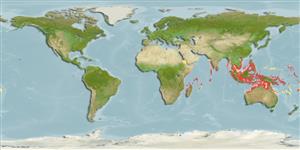Common names from other countries
>
Ovalentaria/misc (Various families in series Ovalentaria) >
Ambassidae (Asiatic glassfishes)
Etymology: Ambassis: Derived from Greek, anabasis = climbing up (Ref. 45335).
More on author: Bleeker.
Environment: milieu / Zona climática / intervalo de profundidade / distribution range
Ecologia
marinhas; Água doce; estuarina demersal; anfídromo (Ref. 59012). Tropical; 19°N - 23°S
Asia: Indo-Australian Archipelago, including Indonesia, the Philippines, Borneo, Java, New Guinea, Vanuatu, New Caledonia, to northern Australia and the Andaman Sea. Reported from Palau (Ref. 6371) and the Ryukyu Islands (Ref. 559).
Comprimento de primeira maturação / Tamanho / Peso / Idade
Maturidade: Lm 7.0 range ? - ? cm
Max length : 12.0 cm TL macho/indeterminado; (Ref. 7050); common length : 5.0 cm SL macho/indeterminado; (Ref. 7242); peso máx. publicado: 12.00 g (Ref. 7242)
Espinhos dorsais (total) : 8; Raios dorsais (total) : 9 - 10; Espinhos anais: 3; Raios anais : 9 - 10. Body very high, 50% of SL. Lateral line incomplete, but a few pored scales on a silvery midlateral band. Lower margin of inter operculum with few spines. The second spine of the first dorsal fin is strong and very long.
Body shape (shape guide): fusiform / normal; Cross section: compressed.
Found in brackish-water, mangrove, estuarine and freshwater-stream habitats, usually within 20 km of the sea (Ref. 2847). They occur at temperatures ranging from 28 to 32°C. Found in schools and migrate to freshwater. Mainly diurnal. A predominantly marine or estuarine spawner. Caught by hand and scoop nets (Ref. 7242).
A nonobligatory plant spawner.
Allen, G.R., 1991. Field guide to the freshwater fishes of New Guinea. Publication, no. 9. 268 p. Christensen Research Institute, Madang, Papua New Guinea. (Ref. 2847)
Status na Lista Vermelha da UICN (Ref. 130435: Version 2025-1)
Ameaça para os humanos
Harmless
Uso pelos humanos
Pescarias: pouco comercial
Ferramentas
Relatórios especiais
Baixar XML
Fontes da internet
Estimates based on models
Preferred temperature (Ref.
123201): 26.7 - 29.1, mean 28.4 °C (based on 1018 cells).
Índice de diversidade filogenética (Ref.
82804): PD
50 = 0.5000 [Uniqueness, from 0.5 = low to 2.0 = high].
Bayesian length-weight: a=0.01148 (0.00659 - 0.02000), b=2.96 (2.81 - 3.11), in cm total length, based on LWR estimates for this species & Genus-body shape (Ref.
93245).
Nível Trófico (Ref.
69278): 2.7 ±0.1 se; based on diet studies.
Resiliência (Ref.
120179): Elevada, tempo mínimo de duplicação da população menor que 15 meses (Fec=29,000-310,000).
Fishing Vulnerability (Ref.
59153): Low vulnerability (10 of 100).
🛈
